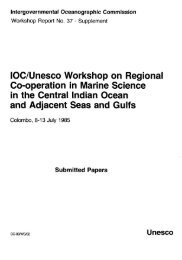The International thermodynamic equation of ... - unesdoc - Unesco
The International thermodynamic equation of ... - unesdoc - Unesco
The International thermodynamic equation of ... - unesdoc - Unesco
- No tags were found...
You also want an ePaper? Increase the reach of your titles
YUMPU automatically turns print PDFs into web optimized ePapers that Google loves.
ΣΑ = Δρ/0<strong>The</strong> <strong>International</strong><strong>The</strong>rmodynamicEquation <strong>of</strong> Seawater– 2010ΣASummary for Policy Makers0Practical Salinity vs. Absolute Salinity Part II:How the Relationship Works Together<strong>The</strong> salinity input to the TEOS-10 Gibbs functionrequires knowledge <strong>of</strong> the Absolute Salinity <strong>of</strong>seawater (S A ), which is based upon the ReferenceSalinity <strong>of</strong> seawater (S R ). <strong>The</strong> ReferenceSalinity is our best estimate <strong>of</strong> the AbsoluteSalinity <strong>of</strong> the seawater that was used to developthe Practical Salinity Scale (S P ), the <strong>equation</strong> <strong>of</strong>state, and the other <strong>thermodynamic</strong> properties<strong>of</strong> seawater. Reference Salinity is related toPractical Salinity byS R = S P –1and Absolute Salinity is related to ReferenceSalinity byδS A = S R + δS Awhere δS A is due to the added solutes in seawaterin deep waters resulting from the dissolution<strong>of</strong> CaCO 3 (soluble) and SiO 2 (soluble), CO 2 , andnutrients like NO 3 and PO 4 from the oxidation <strong>of</strong>plant material. <strong>The</strong> δS A values due to the addedsolutes are estimated from the differencesbetween the measured densities <strong>of</strong> seawatersamples compared with the densities calculatedfrom the TEOS-10 <strong>equation</strong> <strong>of</strong> state at the sameReference Salinity, temperature, and pressure.<strong>The</strong> values <strong>of</strong> δS A in the ocean can be estimatedfor waters at given longitude, latitude, and depthusing correlations <strong>of</strong> δS A and the concentration<strong>of</strong> Si(OH) 4 in the waters. Other methods <strong>of</strong> estimatingδS A are also available in cases wherethe composition changes are measured or canbe modelled. <strong>The</strong> δS A values can then be usedto calculate all the <strong>thermodynamic</strong> properties<strong>of</strong> seawater in the major ocean basins using thenew TEOS-10.Improving the accuracy<strong>of</strong> climate models<strong>The</strong> new <strong>thermodynamic</strong> <strong>equation</strong> for seawater also allows climatemodels to better account for changes in density and heat transferin the ocean. Early tests <strong>of</strong> the use <strong>of</strong> the new <strong>equation</strong> show anestimated 1% change in how the ocean circulates heat from theequator to the poles. <strong>The</strong> change in the West to East temperaturedifference in the equatorial Pacific is about 0.1°C, and this is anotheraspect which is expected to be a valuable improvement in climatemodelling.<strong>The</strong> fundamental properties <strong>of</strong> seawater — salinity,temperature and pressure, along with the freezingand boiling points, heat capacity, speed <strong>of</strong> soundand density — are intricately tied together. Beingable to measure salinity is important, as salinitylevels are indicators <strong>of</strong> climate change. <strong>The</strong>y indicatehow much freshwater is evaporating from theoceans. For instance, parts <strong>of</strong> the Atlantic Oceanappear to be getting saltier. A possible explanationcould be that trapped heat from higher atmosphericconcentrations <strong>of</strong> CO 2 is causing more seawater toevaporate than before, leaving the salt behind.Salinity levels affect water density.Density especially determineswhether a current risestowards the surface or sinks towardsthe seafloor, as the denserthe seawater, the deeper itwill sink. Density depends ontemperature, pressure and theamount <strong>of</strong> dissolved materialin the water. Knowing the density <strong>of</strong> seawateris crucial to monitoring the Earth’s climate. <strong>The</strong>ocean transports heat via currents collectivelycalled the ocean conveyor belt in a processknown as thermohaline circulation. In the Arcticand Southern oceans, cool and salty waters sinkto form deep water currents. Over thousands<strong>of</strong> years, these currents travel around the worlduntil they reach areas <strong>of</strong> upwelling which bringthem to the surface. Once at the surface, thesun-warmed, rain-freshened currents head back6
















